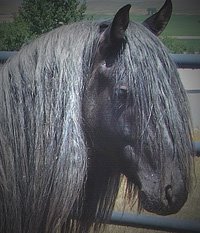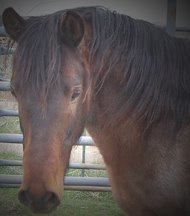Whew! It's been a long week. My apologies for the delay in continuing this series. You may recall that we've been talking about
the importance of fitness for endurance riders in particular. My goal, as I stated in
Part One, is to achieve leanness,
cardiovascular endurance, and a high level of functional strength supported by whole food nutrition.
In Parts
Three and
Four of this series, I posted the first two rules for eating clean, which I defined as fueling your body with the substances it is designed to ingest. Since I interrupted myself with a few days' worth of unrelated posts, here's a quick reminder:
Eating Clean Rule #1: Don't eat anything with a barcode.
Eating Clean Rule #2: Sugar is the devil.Between these two rules, we eliminated the vast majority of what most people in western cultures eat, leaving behind a short list of foods that can be mixed and matched in an astonishing array of delicious, healthful meals: Vegetables. Fruits. Legumes. Meats. Eggs. Nuts. Seeds. Plant oils. Grains. Milk.
Obviously, this list can be divided into two, major categories: plant matter and animal products...which leads me to...
Eating Clean Rule #3: Eat Mostly Plants

Don't panic! I said
mostly.
Many of you know that I've spent the last three years as a "
flegan." That's a contraction I invented in a facetious moment to describe my diet of flexible
veganism. (Hey, the
flexitarians are allowed
their oxymoron!)
As I explain in
this post on
Nightlife,
fleganism was a lifestyle into which I fell somewhat by accident. When a summer's bounty from my home garden crowded most other foods off my plate for nearly three months, I experienced such obvious
improvements in my health that I never felt the need to return to my old habits of basing meals on meats, poultry, and cheeses.
What health benefits, you ask?
Improved body fat ratio, for one. Compare these photos again:

Both represent times in my life when I had a farm full of horses and a house full of pets to keep me active. However, the first photo was taken when I still based two meals a day on chicken, pork, beef, or pasta; the other was snapped after about a year of
fleganism.

Note that the second photo was taken last summer, six months
before I started
bodybuilding (NOT the steroid-ridden, appearance-based, fake stuff you see in magazines, but genuine body
conditioning to increase my functional strength -- a topic I'll address later in this series.) Now, I'm not preparing to make a case for
vegetarianism, but I will tell you this: About 80% of leanness (and the muscle definition that goes along with it) is the result of diet, not exercise, and
certainly not endless
cardio routines!
But I'm getting ahead of myself. Back to those health benefits I experienced when I started following eating mostly plants. My new practice of basing meals on vegetables, fruits, beans, and whole grains -- to the exclusion of all animal products, including dairy and eggs, with rare exceptions -- resulted in total elimination of my seasonal allergies, which had been severe, and dramatic reduction in the frequency and intensity of the arthritis pain caused by my bunions.
Miraculous?
Unbelievable? Not really. (Hell, allergies are nothing. Some people have cured
cancer through nutrition alone!) All I did was give my body the nutrients it needed to heal itself.
Note that the key point here is what I
added to my diet (piles and piles of produce)...
not what I removed (animal products). There are plenty of strong, lean, healthy people who eat animal products, and plenty of strong, lean, healthy people who don't. Depending on what one is trying to accomplish with regard to strength, however, the latter can be a challenge. I've recently found it necessary to add two eggs per day, plus some seafood, to my diet in order to meet my body's protein and energy demands in the face of ongoing body conditioning.
Regardless of one's opinion on
vegetarianism, the point is that a healthful diet must be primarily plant-based. "Primarily," of course, is a relative term. Opinions abound on what percentage of one's daily calories should come from plant foods -- vegetables, fruits, legumes, grains, nuts, seeds, and plant oils -- let alone from each of these sub-categories.
Proponents of Primal/
Paleo eating, which I think has a lot of merit
if followed correctly and consistently, particularly with regard to the reduction in carbohydrate consumption, emphasize a
considerably higher percentage of animal products than I tend toward, but still maintain a foundation of plenty of vegetables and some fruit. I also agree with the
Paleo People's emphasis on fats (natural fats, that is, from real foods -- not the
man made fats that, along with
man made sugars, turn processed "foods" into poisons.) For those who want to know more,
Mark's Daily Apple and
Fitness Spotlight are excellent blogs that will tell you all you need to know about going
Paleo.
One thing is certain: the diet that is best for one person is not necessarily
appropriate for another. However, any
predominantly plant-based diet that also complies with Eating Clean Rules 1 & 2 is beneficial. Do your homework, experiment with what makes sense, and choose the diet that best helps you achieve your goals. Just be sure you're basing your decisions on
physiological needs, not
psychological desires. "I can't live without ice cream" is not a good reason to insist upon dairy as a regular feature on your table! (No more is "I avoid dairy" a valid reason to avoid the very-occasional scoop of Moose Tracks.)
As you experiment with your personal diet, here are a few things to bear in mind:
- The great benefit of plants is found less in macronutrients (carbohydrates, proteins, and fats, all of which plants also provide), than in micronutrients (vitamins, minerals, and phytonutrients). Micronutrients are critical to survival; they're the necessary components that enable the body to identify and rectify those external threats and internal errors that will, if left unchecked, lead to disease. The more micronutrients you put in your body, the better it will be able to defend and heal itself. In the process of obtaining all those micronutrients, of course, you'll taking in most of the macronutrients you need as well.
- Plants shouldn't have barcodes. Fresh vegetables, fruits, herbs, legumes, and grains are vastly superior to their canned, dried, or frozen counterparts. Grains should look like they were just shaken loose of their chaff, and maybe run under a roller. They should not reach your mouth in the form of loaves, rolls, wafers, or flakes (check out that link for the alarming history of your breakfast cereal!) Nuts and seeds should be raw, not roasted and salted. Plant oils (which most of us cannot obtain outside a barcoded bottle) should contain no additives.
- Fresh is better. As soon as a plant is picked, its nutrient density begins to decrease. Therefore, it is ideal to concentrate your produce consumption on varieties that are locally grown and in season. Organic produce, which generally has the opportunity to grow in richer soils than does conventional produce, and which is proven to contain more nutrients (which comprise the plant's own defense system and are therefore more concentrated in plants unshielded by man made pesticides) is preferable as well. That said, conventional, out-of-season produce grown in a different hemisphere is preferable to no produce at all...for nutritional purposes, anyway. See Barbara Kingsolver's book Animal, Vegetable, Miracle: A Year of Food Life for an engaging and intelligent discussion on the merits of eating locally produced foods.
- Fresh and raw is best. (Some would argue this point. See this post for details.) A bit of creativity is all it takes to ensure that you consume at least half your daily produce in an uncooked state, without overdosing on garden salads. I'll share some of my ideas for doing so in a future post.
Speaking of my personal eating habits, anyone who has spent significant time in my presence knows that I eat a lot, in terms of both volume and frequency. You've heard the USDA's recommendation that you eat 5-9 servings of fruits and vegetables per day? Yeah. It's not uncommon for me to eat that much produce before lunch.
Indeed, one of the benefits of a smart, plant-based diet is that it's almost impossible to overeat. Your body's satiation center will stop you before you can consume an overabundance of vegetables, fruits, or legumes, particularly if much of the produce is raw. (It is wise, however, to remain attentive to the volume of whole grains, nuts, seeds, and oils in your diet.)
 For those who are already lean and are working on building strength, the inclusion of some animal products is likely to prove beneficial. Part Six of this series will cover some of the issues related to meats, dairy, and eggs. I'll also discuss grains in further detail, as they are the source of much debate among the lean, the strong, and those endeavoring to become so.
For those who are already lean and are working on building strength, the inclusion of some animal products is likely to prove beneficial. Part Six of this series will cover some of the issues related to meats, dairy, and eggs. I'll also discuss grains in further detail, as they are the source of much debate among the lean, the strong, and those endeavoring to become so.
_________________________________________________________
Related Posts
Fit to Ride, Part One: Going for the Goal
Fit to Ride, Part Two: Vice and Advice
Fit to Ride, Part Three: Eating Clean
Fit to Ride, Part Four: Sweet Surrender
Fit to Ride, Part Six: Milk Got You?
Straight Sailing: Thoughts on Fitness for Endurance Riders
_________________________________________________________
Want to read more posts like this one?
Subscribe to The Barb Wire

























